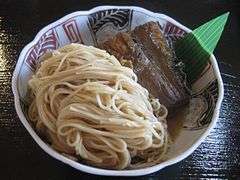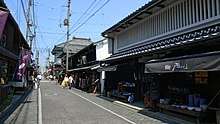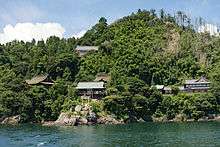Nagahama, Shiga
Nagahama (長浜市, Nagahama-shi) is a city located in Shiga Prefecture, Japan on the northeastern shore of Lake Biwa. The city center was developed and renamed by Toyotomi Hideyoshi when Hideyoshi moved the center of his administration from Odani Castle. Kunitomo (国友), the northeast of the city center, had been known for the production of arquebuses and guns since 1544.
Nagahama 長浜市 | |
|---|---|
 Kurokabe square and main shopping street of central Nagahama | |
 Flag | |
 Location of Nagahama in Shiga Prefecture | |
 Nagahama Location in Japan | |
| Coordinates: 35°23′N 136°17′E | |
| Country | Japan |
| Region | Kansai |
| Prefecture | Shiga Prefecture |
| Government | |
| • Mayor | Nobuya Kawashima |
| Area | |
| • Total | 680.79 km2 (262.85 sq mi) |
| Population (October 1, 2016) | |
| • Total | 119,043 |
| • Density | 170/km2 (450/sq mi) |
| Time zone | UTC+9 (JST) |
| City hall address | 12-34 Takada-chō, Nagahama-shi, Shiga-ken 526-8501 |
| Website | www |
As of October 1, 2016, the city has an estimated population of 119,043 and a population density of 170 persons per km². The total area is 680.79 km².
The current city is now historically located within three former districts; Sakata District, Higashiazai District and Ika District.
The naming
Nagahama used to be known as Imahama (今濱), but Toyotomi Hideyoshi renamed it Nagahama for Oda Nobunaga. It is not related to the area of the same name in Fukuoka City and same name town in Ehime Prefecture.
History

On April 1, 1943, the town of Nagahama from Sakata District merged with six other towns to gain city status. The last population count was conducted on December 1, 2005, and the city had a population of 63,057. The total area was 45.50 km².
On February 13, 2006, the towns of Azai and Biwa (both from Higashiazai District) were merged into Nagahama, which replaced all municipal organizations—including the old city of Nagahama itself. As a result of the city's annexation of Azai and Biwa in 2006, the total population stood at 84,410.
On January 1, 2010, the towns of Kohoku and Torahime (both from Higashiazai District), and the towns of Kinomoto, Nishiazai, Takatsuki and Yogo (all from Ika District) were merged into Nagahama. Both districts were thereby dissolved as a result of this merger.[1]
Sightseeing
Nagahama is one of the most famous tourist cities in Shiga. Attractions to be found in the city include:
- Central Nagahama
- Nagahama Castle
- Kurokabe Square (aka "Black Wall Square"), shopping streets centered a black wall glasswork shop which made use of an old bank building.
- The Old Nagahama Station Museum, built in 1882 and the oldest preserved railroad station in Japan.
- The Nagahama Roman Beer Brewery
- Nagahama Flintlock Gun Museum
- Nagahama Hachimangu Shrine
- Daitsū-ji Temple, the largest temple in central Nagahama
- Shana-in Temple
- Soji-ji Temple
- Jinsho-ji Temple
- Chizen-in Temple
- Hōkoku Shrine
- Nagahama Hikiyama Festival event on April 13–16, every year, since Azuchi-Momoyama period.
- Nagahama Bonbai (bonsai of ume) event on January 20 to March 10, every year, since 1952.[2]
- Tonda Traditional Bunraku Puppet Troupe
- Lake Biwa
- Odani Castle
- Anegawa River
- Mount Shizugatake
- Lake Yogo
Cuisine

In addition to the usual Shiga Prefecture cuisine, most famously funa-zushi, Nagahama has a local specialty of salty-sweet cooked sōmen with mackerel (焼鯖素麺, yaki-saba sōmen), related to its historical position on the mackerel highway.
Sister cities
The following cities were once sister cities of the former city of Nagahama.
Within Japan
Gallery
- Nagahama Castle in the spring
 Kurokabe Square
Kurokabe Square Old Nagahama Station
Old Nagahama Station Daitsu-ji Temple
Daitsu-ji Temple Chikubu Island
Chikubu Island View of Lake Biwa and Chikubu Island
View of Lake Biwa and Chikubu Island Lake Yogo
Lake Yogo
References
- "Archived copy". Archived from the original on 2008-04-18. Retrieved 2008-09-07.CS1 maint: archived copy as title (link)
- Nagahama city. 長浜盆梅展のはじまり [The origin of Nagahama Bonbai] (in Japanese). Archived from the original on 2011-10-09. Retrieved 2011-08-28.
- "Escolas Brasileiras Homologadas no Japão" (Archive). Embassy of Brazil in Tokyo. Retrieved on October 13, 2015.
External links
| Wikimedia Commons has media related to Nagahama, Shiga. |
| Wikivoyage has a travel guide for Nagahama. |
- Nagahama City official website (in Japanese)
- Nagahama Tourism Association (in Japanese)